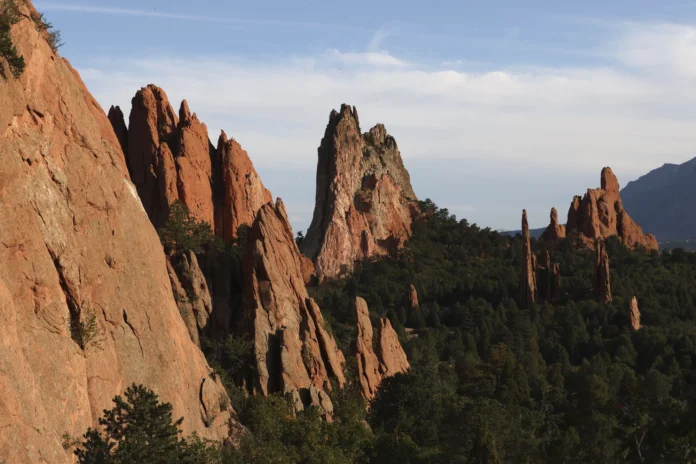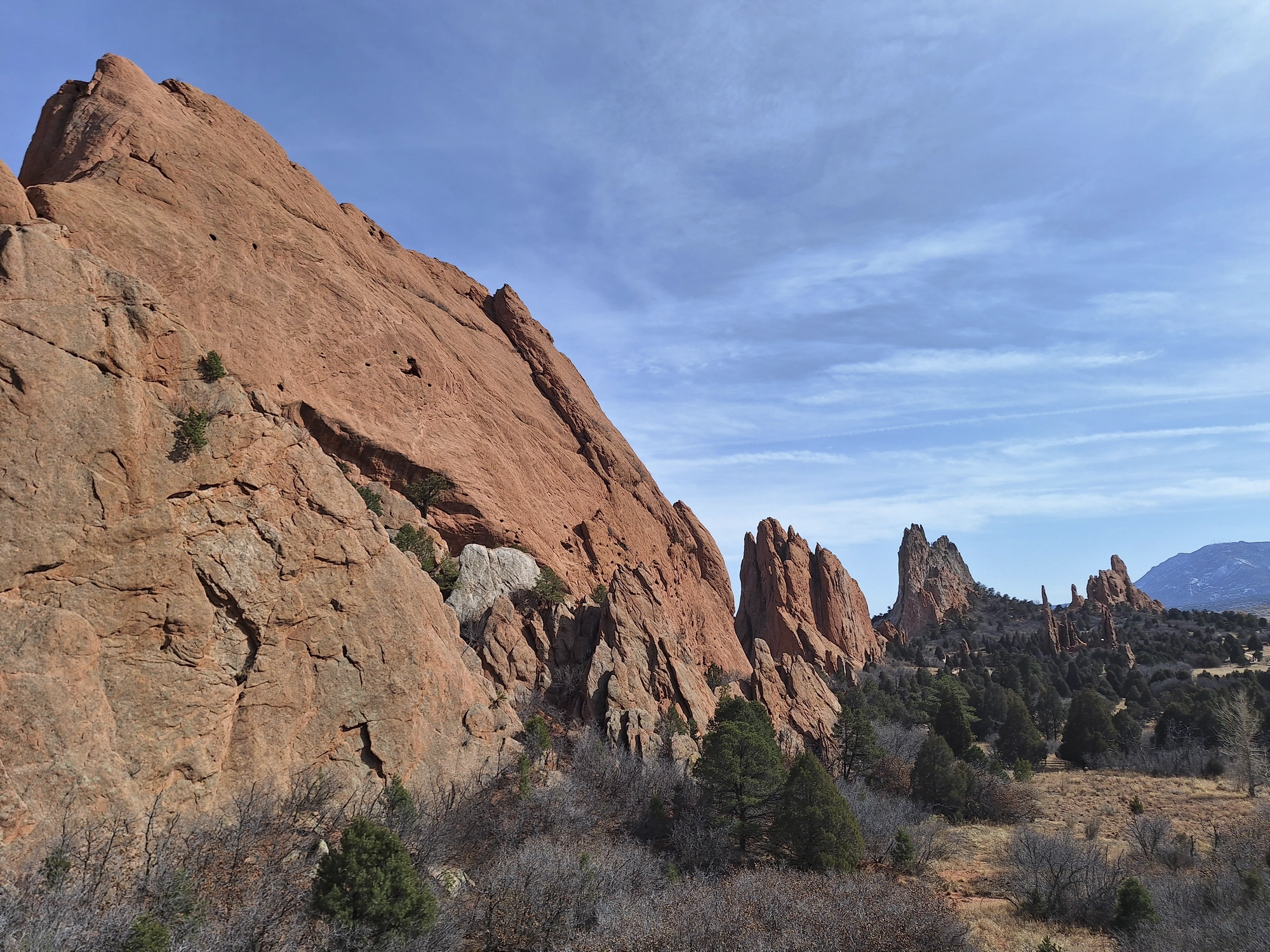I first visited Garden of the Gods with a camera slung over my shoulder and more enthusiasm than skill. Over the years, I’ve returned countless times, chasing changing light, dramatic skies, and that sense of quiet awe the park inspires. As my journey into photography has deepened, so has my fascination with this otherworldly place — not just its towering red rocks, but its story: the deep geologic forces that sculpted it, the layers of human history embedded in its trails, and the way it continues to draw people from all over the world.
A Land Born of Deep Time
Standing beneath the sandstone fins of Garden of the Gods, it’s easy to feel small — not just in scale, but in time. These formations began as sand dunes and shallow sea sediments more than 300 million years ago. Over eons, tectonic forces lifted and fractured the earth. During the Laramide Orogeny — the mountain-building event that also pushed up the Rocky Mountains around 65–70 million years ago — the horizontal layers were tilted to near vertical. That’s why the park’s famous fins, like Kissing Camels and Cathedral Spires, rise dramatically from the prairie, as if thrust upward by unseen hands.
Geologists divide the visible rocks here into several formations. The oldest is Pikes Peak granite, nearly 1.1 billion years old, but what most visitors notice are the younger Permian-to-Jurassic sandstones. The bright red Lyons Formation forms many of the dramatic fins. Above it lie the softer Fountain Formation and Dakota Sandstone, each telling a story of ancient rivers, floodplains, and inland seas. Iron oxide gives the rocks their fiery hue, while cross-bedding patterns still whisper of wind-blown dunes.
When I photograph here, I think about that span of time: how a single sunrise barely registers against the slow grind of geologic uplift and erosion. Yet light — fleeting and ephemeral — is what makes these ancient stones come alive through a lens.
First Peoples and Sacred Landscapes
Long before Colorado Springs existed, Native peoples knew and revered this landscape. Archaeological evidence suggests human presence in the region for thousands of years. The Ute, Apache, Comanche, and later the Arapaho and Cheyenne passed through or lived nearby. For the Ute, especially, these soaring rocks carried spiritual significance. Oral traditions speak of the Garden as a place of ceremony and vision.
Petroglyphs once existed in the area, though many were lost to time and vandalism. Still, the sense of sacred space persists. When I walk the trails at dawn, with deer moving silently through junipers and mule deer tracks pressed into red dust, I imagine what it felt like to stand here centuries ago, seeing the same rock silhouettes against the rising sun.
Explorers, Settlers, and the Birth of a Park
European-American exploration reached the region in the 1700s and early 1800s, as Spanish expeditions and later trappers and surveyors crossed the Front Range. But the park’s modern story began in 1859, when Melancthon Beach and Rufus Cable arrived during the Pikes Peak Gold Rush. Legend says Cable exclaimed the site would be “a capital place for a beer garden… but a fit place for the gods to assemble,” coining the name we use today.
The land changed hands several times before becoming public. Railroad magnate Charles Elliott Perkins purchased much of the property in 1879, intending to preserve its beauty rather than exploit it. When Perkins died in 1909, his children honored his wish to keep the land free for the public, deeding 480 acres to the City of Colorado Springs. They required it remain open, free of charge, and preserved “in its natural state.” That promise still shapes the park today.
Walking with my camera, I often think about that gift. In a time when development could have consumed the landscape, a family’s decision kept it wild and accessible for everyone — artists, hikers, families, and photographers like me.
Natural Resources and Conservation Challenges
Garden of the Gods isn’t just a pretty backdrop; it’s an ecosystem. The park straddles the meeting point of plains and mountains, creating surprising biodiversity. Pinyon pines and junipers grow beside prairie grasses. Mule deer browse in the meadows, black-billed magpies chatter in the trees, and occasionally a red fox slips across the trail at dusk.
Water here is scarce but vital. The park contains springs and seasonal streams, though much of the area depends on rainfall and snowmelt. Historically, nearby creeks fed small agricultural ventures, and settlers grazed livestock on what is now protected land.
Today, conservation challenges center on erosion and human impact. Millions visit each year — the park regularly ranks among Colorado’s most visited natural attractions, with well over four million annual guests. Foot traffic compacts soil, carves social trails, and accelerates wear on fragile rock. City parks staff and volunteers work constantly to repair paths, manage invasive plants, and balance access with protection.
I’ve noticed this firsthand as a photographer. Some classic vantage points now have fences or designated overlooks to keep visitors safe and minimize damage. It’s a necessary trade-off: preserving beauty while sharing it.
Tourism: A Free Wonder in a Busy World
One of the most remarkable things about Garden of the Gods is that it’s still free to enter. In an era of rising park fees and privatized attractions, this city-owned park welcomes everyone. That openness shapes the tourism experience.
The Visitor & Nature Center offers geology exhibits, maps, and tips — but most visitors quickly hit the trails. The paved Perkins Central Garden Trail winds among the tallest fins, accessible even to wheelchairs and strollers. More adventurous travelers tackle trails like Siamese Twins, Palmer Trail, or the Balanced Rock area. Rock climbing is allowed with a free permit and proper gear; on clear mornings you can spot climbers silhouetted against blue sky.
Beyond hiking and climbing, the park draws cyclists, horseback riders, and photographers chasing sunrise or alpenglow on Pikes Peak. Local outfitters offer jeep and Segway tours, while families picnic under cottonwoods. Because it’s within minutes of downtown Colorado Springs, it’s easy to combine with other stops like Pikes Peak Highway, Cave of the Winds, or the Manitou Incline.
Tourism has long been part of the park’s story. In the late 1800s and early 1900s, visitors arrived by horse carriage or early automobiles, often staying at nearby grand hotels. Postcards of Balanced Rock and Gateway Rocks spread its fame nationwide. Today, social media fills that role — every day, countless travelers post their own #gardenofthegods shots, adding to its mystique.
As a photographer, I feel both camaraderie and challenge when I see so many cameras here. The park is photographed endlessly, yet every visit offers new light and weather. A storm rolling off Pikes Peak, or the first snow dusting red rock, can still yield something unique.
A Photographer’s Playground
Garden of the Gods has become my classroom. Its sheer variety — jagged spires, sweeping vistas, wildlife, and shifting skies — forces me to grow. I’ve learned to work with harsh midday sun bouncing off sandstone, to wait for soft dawn light, to use long exposures when clouds race over the hogbacks.
Some of my favorite spots: North Gateway Rock at sunrise, when the east-facing cliffs blaze orange; the Siamese Twins Arch, framing Pikes Peak; and the lesser-visited Ridge Trail, where solitude and views come easier. In winter, fresh snow outlines every ledge and crevice — a photographer’s gift.
Photography here isn’t just technical; it’s emotional. This is a place where deep time and fleeting light meet. Each visit reminds me why I picked up a camera in the first place: to witness, to share, to feel connected to something bigger.
Practical Tips for Fellow Travelers
If you plan to visit:
- Go early or late. Crowds and parking can be intense midday. Sunrise and sunset offer better light and quieter trails.
- Check the weather. Colorado can change quickly — storms roll off the mountains fast.
- Respect the rock. Stay on trails, follow climbing regulations, and avoid carving or chalking formations.
- Visit the Visitor Center first. It’s free and offers great insight into geology and history.
- Pair with nearby attractions. Manitou Springs, Old Colorado City, and Pikes Peak Highway make for a full day of exploring.
Why It Keeps Calling Me Back
Every time I pack up my gear and head to Garden of the Gods, I wonder what new angle or moment I’ll find. Sometimes it’s a mule deer stepping into a shaft of light. Sometimes it’s a thunderhead turning the red rock almost purple. Sometimes it’s simply the quiet — the way this park holds space for reflection even among the tourists.
The history here runs deep: from ancient seas to Ute ceremonies, from railroad barons to conservationists. The geology is a masterclass in patience. And the present, bustling with hikers and photographers, proves that some gifts — like a free, wild park in the middle of a growing city — still matter.
For me, Garden of the Gods is more than a backdrop. It’s a teacher, a sanctuary, and a reminder that beauty is both ancient and ever-new if you’re willing to look closely. With every visit, camera in hand, I feel like I’m stepping into a story that began long before me and will continue long after. That’s humbling — and inspiring.
References and research









